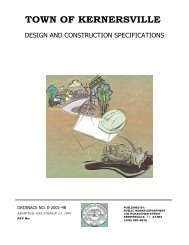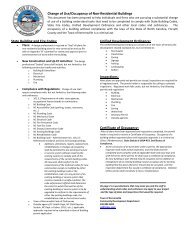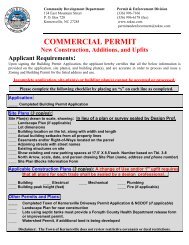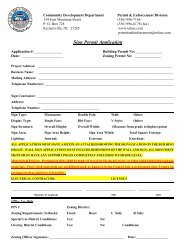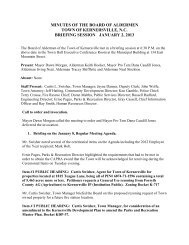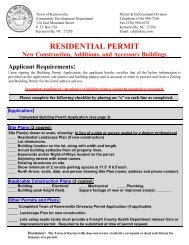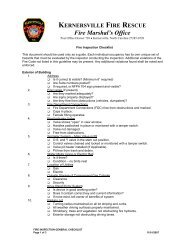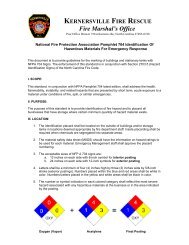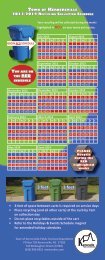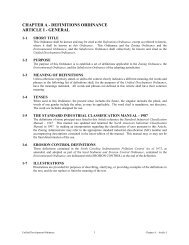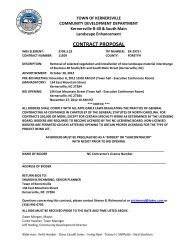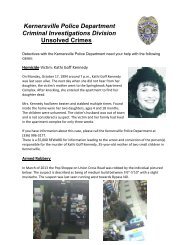Piedmont Greenway Master Plan - Town of Kernersville
Piedmont Greenway Master Plan - Town of Kernersville
Piedmont Greenway Master Plan - Town of Kernersville
- No tags were found...
Create successful ePaper yourself
Turn your PDF publications into a flip-book with our unique Google optimized e-Paper software.
PL 566-Watershed Protection and Flood Prevention Act<br />
Local communities can receive funding for greenway projects that incorporate flood prevention and<br />
watershed protection through this act. (http://www.nrcs.usda.gov/programs/watershed/index.html, contact:<br />
Bruce Julian, National Policy Coordinator, Water Resources, 202-720-3042)<br />
Local Funding Sources<br />
Taxes<br />
<strong>Greenway</strong>s can be funded through sales tax revenues. One example <strong>of</strong> a community that is using sales<br />
tax dollars to fund bicycle and pedestrian facilities is Cobb County, Georgia, where citizens voted to implement<br />
a one percent local sales tax to provide funding for transportation projects. Over four years, Cobb<br />
County DOT will receive $3.8 million <strong>of</strong> this sales tax revenue for bicycle improvements alone, to be used<br />
as a match for federal dollars. Another example is Oklahoma City, where voters approved a temporary<br />
$0.01 sales tax, which generated millions <strong>of</strong> dollars for greenway acquisition and development.<br />
In order to raise the sales tax above the current level, the cities and/or counties will need approval from<br />
the General Assembly, which may be currently reluctant to grant an additional statewide local option sales<br />
tax.<br />
Impact Fees<br />
Impact fees are monetary onetime charges levied by a local government on new development. Unlike<br />
required dedications, impact fees can be applied to finance greenway facilities located outside the boundary<br />
<strong>of</strong> development. The General Assembly has permitted a “small but growing number <strong>of</strong> local governments to<br />
impose impact fees.” These fees can be levied through the subdivision or building permit process to finance<br />
greenways.<br />
Bond Referendums<br />
Communities across the nation have successfully placed propositions on local ballots to support<br />
greenway development. The Charlotte-Mecklenburg County, NC, area passed four consecutive referenda<br />
that generated more than $3 million for greenways. In 1988 Guilford County, NC also passed a referendum<br />
that appropriated $1.6 million for development <strong>of</strong> the Bicentennial Trail. If a city chooses to propose a bond<br />
referendum, the city should consider combining the needs <strong>of</strong> the pedestrian thoroughfare plan and parks and<br />
recreation plan with the greenways plan. Since bonds rely on the support <strong>of</strong> the voting population, an aggressive<br />
education and awareness program will need to be implemented prior to any referendum vote.<br />
Local Capital Improvements Program<br />
Some local governments have initiated a yearly appropriation for greenway and trail development in<br />
the capital improvements program. In Raleigh, NC, greenways continue to be built and maintained, year<br />
after year, due to a dedicated source <strong>of</strong> annual funding that has ranged from $100,000 to $500,000,<br />
administered through the Parks and Recreation Department.<br />
Trail Sponsors<br />
A sponsorship program for trail amenities allows smaller donations to be received from both<br />
individuals and businesses. The program must be well planned and organized, with design standards<br />
and associated costs established for each amenity. Project elements that may be funded can include<br />
wayside exhibits, benches, trash receptacles, entry signage and picnic areas. Usually, plaques recognizing<br />
individual contributors are placed on the constructed amenities or at a prominent entry point<br />
to the trail.<br />
Local Private Sector Funding<br />
Local industries and private businesses may agree to provide support for development <strong>of</strong> the<br />
greenway through:<br />
• Donations <strong>of</strong> cash to a specific greenway segment;<br />
• Donations <strong>of</strong> services by large corporations which reduce the cost <strong>of</strong> greenway implement<br />
ation, including equipment and labor to construct and install elements <strong>of</strong> the greenway;<br />
• Reductions in the cost <strong>of</strong> materials purchased from local businesses that support greenway<br />
implementation and can supply essential products for facility development.<br />
One example <strong>of</strong> a successful endeavor <strong>of</strong> this type is the Swift Creek Recycled <strong>Greenway</strong> in<br />
Cary, NC. A total <strong>of</strong> $40,000 in donated construction materials and labor made this trail an awardwinning<br />
demonstration project. This method <strong>of</strong> raising funds requires a great deal <strong>of</strong> staff coordination.<br />
(Note: Some materials used in the “recycled trail” were considered waste materials by local<br />
industries.)<br />
Volunteer Work<br />
Community volunteers may help with greenway construction, as well as conduct fund-raisers.<br />
Individual volunteers can be recruited with those from local organizations such as church groups,<br />
civic groups, scout troops and environmental groups.<br />
A case in point is Cheyenne, Wyoming’s volunteer greenway program. The Greater Cheyenne<br />
<strong>Greenway</strong> has motivated an impressive amount <strong>of</strong> community support and volunteer work. The program<br />
has the unusual problem <strong>of</strong> having to insist that volunteers wait to begin landscaping the trail<br />
until construction is completed. A manual for greenway volunteers was developed in 1994 to guide<br />
and regulate volunteer work. The manual includes a description <strong>of</strong> appropriate volunteer efforts,<br />
PIEDMONT GREENWAY<br />
Final <strong>Master</strong> <strong>Plan</strong> Report • 73



